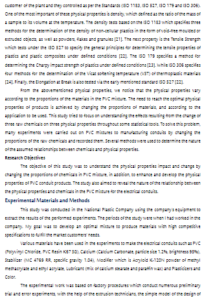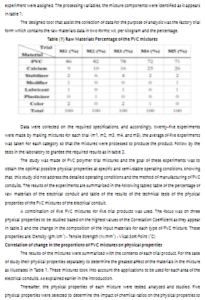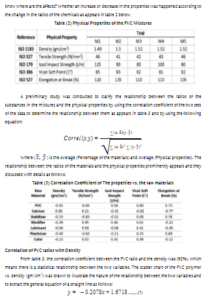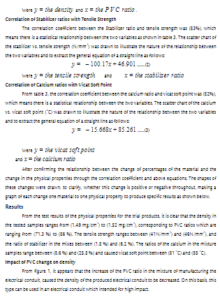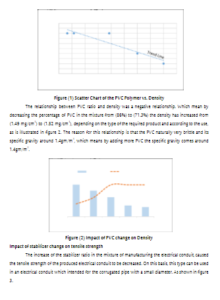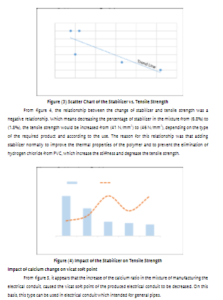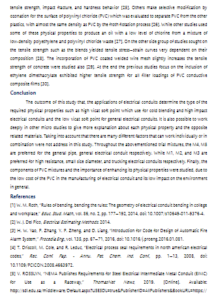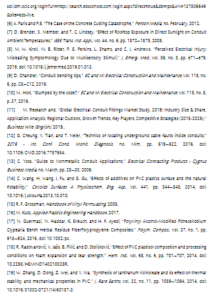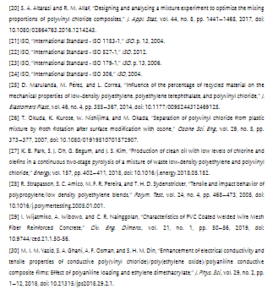Impact of PVC mixtures of the Electrical Conduit on the Physical Properties
AbdelHamid M.S. Esmail
Jubail Technical Institute || Education Sector || Royal Commission for Jubail & Yanbu || KSA
DOI PDF
Tab title
The use of PVC mixtures in the manufacturing of electrical conduit has been employed for a long time along with other materials. In this study, the impact of changing the ratio of the components of the PVC mixtures on the physical properties of the electrical conduit was investigated. The emphasis was placed on three properties: Density, Tensile Strength and Soft Point. The application of the electrical conduit controls the types of materials and their percentages. Physical properties of the PVC products are the most important factors that help to choose compared with other materials. These properties change with the change of the chemical components of the PVC mixture. The study discussed how to enhance and improve these properties by controlling the proportions of some substances in the PVC mixtures. This article aims to demonstrate the strong relationship between PVC polymer, calcium and stabilizers and the physical properties of the electrical conduit. The focus concentrated on three components in the mixture and three physical properties. Random samples were taken to calculate the average percentages of the components in the mixtures. Various tools and several statistical methods were used such as correlation coefficients and scatter charts to prove the relationship between the ratios of the materials and the respective properties. The correlation coefficients between the PVC polymer, stabilizers, calcium, and the density, tensile strength, vicat soft points were (0.92, 0.83, 0.82) respectively. Decreasing the PVC polymer by (17.1%) has caused an increase in the density of the conduit by (2%). Finally, the physical properties of PVC mixtures could be improved by changing component ratios to reach the optimized mixture for the specific application, taking into account other competitive issues such as the final price of the product, environmental impact, and other issues. Keywords: Density, Tensile Strength, vicat soft point, PVC polymer, Calcium, Stabilizer.
تأثير خلطات البي في سي لصناعة القنوات الكهربائية على الخواص الفيزيائية
عبد الحميد محمد سعيد إسماعيل
معهد الجبيل التقني || التابع لقطاع الكليات والمعاهد بالهيئة الملكية بالجبيل || المملكة العربية السعودية
Tab title
تم استخدام خلطات البي في سي في تصنيع قنوات الأسلاك الكهربائية البلاستيكية إلى جانب مواد أخرى من فترة طويلة. في هذه الدراسة، تم دراسة تأثير تغيير نسب مكونات خلطات البي في سي على الخصائص الفيزيائية لقنوات الأسلاك الكهربائية. تم التركيز على ثلاث خصائص: الكثافة، قوة الشد، نقطة التليّن. يتحكم استخدام قنوات الأسلاك الكهربائية في أنواع المواد الداخلة ونسبها المئوية في الخلطة. الخصائص الفيزيائية لمنتجات البي في سي هي أهم العوامل التي تساعد على الاختيار مقارنة بالمواد الأخرى. تتغير هذه الخصائص مع تغير المكونات الكيميائية لخليط البي في سي. ناقشت الدراسة كيفية تحسين وتطوير هذه الخصائص من خلال التحكم في نسب بعض المواد في خلطات البي في سي. تهدف هذه الدراسة إلى إثبات العلاقة القوية بين بوليمر البي في سي والكالسيوم والمثبتات الداخلة في الخلطة والخصائص الفيزيائية لقناة الأسلاك الكهربائية. وتم التركيز على ثلاث مكونات في الخليط وثلاث خصائص فيزيائية. تم أخذ عينات عشوائية لحساب متوسط النسب المئوية للمكونات في الخلطات. وتم استخدام أدوات متنوعة وعدة طرق إحصائية مثل معاملات الارتباط والمخططات المبعثرة لإثبات العلاقة بين نسب المواد والخصائص المعنية. كانت معاملات الارتباط بين بوليمر البي في سي، والمثبتات، والكالسيوم من ناحية والكثافة، وقوة الشد، ونقطة التليّن (0.92، 0.83، 0.82) على التوالي. كما تسبب انخفاض بوليمر البي في سي بنسبة (17.1٪) في زيادة كثافة قناة الأسلاك الكهربائية بنسبة (2٪). أخيرًا، يمكن تحسين الخواص الفيزيائية لخلطات البي في سي من خلال تغيير نسب المكونات للوصول إلى الخليط الأمثل للتطبيق المحدد، مع مراعاة المشكلات التنافسية الأخرى مثل السعر النهائي للمنتج، والأثر البيئي، والعوامل الأخرى. الكلمات المفتاحية: الكثافة، قوة الشد، نقطة التليّن، بوليمر البي في سي، الكالسيوم، المثبت.
Introduction
The electrical conduit is a pipe used to ensure the protection of electrical cables and wires in construction. The main goal of using the conduit is for safety reasons, electrical wiring has to be shielded and grounded, which is achieved by running it, where necessary, through electrical conduits [1]. The conduits used for different applications such as power distribution, branch lighting, branch power, and conduit for fire alarm or data cabling [2]. Uses of electrical conduits fall under specific laws and regulations that vary from country to country. The goal of these legislations and standards is to control the specifications and the manufacturing of the conduit industry. Example of that, the concealed wiring protection, in the old standard, it was required to adopt the rigid plastic tube with fire retardant treatment, while in the new standard, it is revised to flexible rigid plastic tube above grade [3]. Some originations work on these standards such as National Electrical Code, the Canadian Electrical Code and the National Electrical Manufacturers Association, which was updated Standard for Electrical Intermediate Metal Conduit Raceways, as an example [4] [5]. The primary engine of these updates is the safety issue, if safety issues are ignored, incidents such as Concrete Cutting Catastrophe could occur. When “five parallel electrical conduits running perpendicular to the concrete cut. Four of the conduits were laid directly on the soil and were encased in concrete, while the fifth was running beneath the soil” [6]. Therefore, standards organizations reveal and clarify updated standards so that they are not misunderstood for example, when electrical conductors are placed in conduits located in sunlight, the interiors of those conduits can reach quite high temperatures [7]. This leads to talk about the physical properties of these conduits and their tolerance to operating conditions and how to improve them. In the case of non-specialists work in the installation of these electrical conduits an electrical accident could happen, for example, hearing the sound and seeing the bright flash of an electrical arc can create the false impression that someone had experienced an electrical shock [8]. There are several ways and techniques to work on electrical conduits, whether underground or outside [9]. What makes it necessary to the skillful technician to know the physical properties of electrical conduits and their types. The common uses of PVC conduit are concealed within walls, floors, or ceilings, directly buried or embedded in concrete in buildings of any height [10]. Cost also forms another dimension, The global electrical conduit fittings market is set to exhibit a CAGR of 6.7% during the forecast period from 2018 to 2026. Electrical conduit systems are the most common type of wiring installations worldwide [11]. However, It is important to fully utilize the technics of locating underground cable faults inside conduits [12]. Generally, the conduits vary based on their uses such as:

